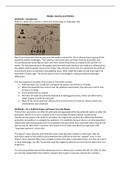Summary
Samenvatting Making Sense of Media and Politics, ISBN: 9781000550634 Media Society and Politics (S_P4SMA)
- Course
- Institution
- Book
This is a complete summary of the course MMP/MSP. Thus, lecture notes, book summary, and article summaries
[Show more]




